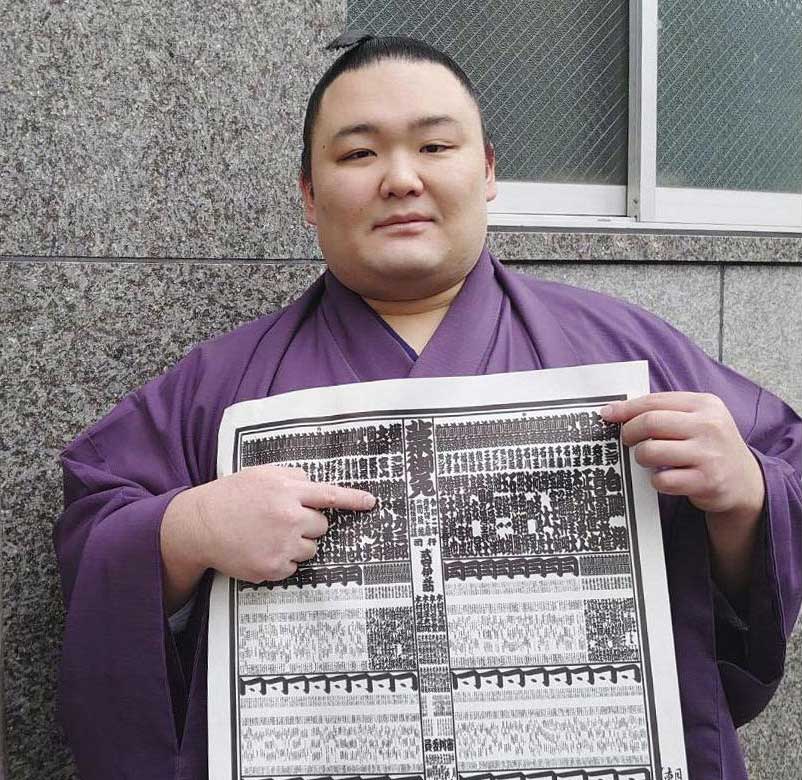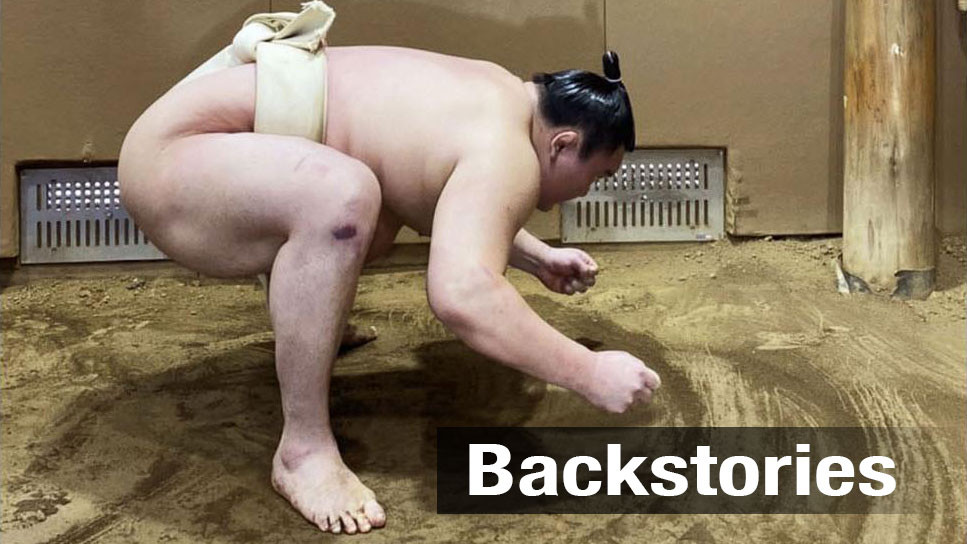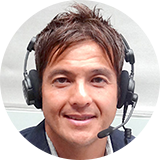May tournament canceled
The March tournament in Osaka went ahead. But there were no spectators in the seats for the first time in the sport's history, in a move to prevent the spread of the new coronavirus among sumo association members. Fans were hoping for things to get back to normal for the May contest and see the wrestlers compete in front of their own eyes at the tournament venue.
As a precautionary measure, the association announced two-week postponements of the May and July tournaments on April 3. The opening day of the May tournament was moved from May 10 to 24, in the hope the virus would be contained by then.
Although the March tournament finished without any apparent infections, the world of professional sumo did not remain immune for much longer. In early April, the association announced that a wrestler in the lower division had become the first person in professional sumo to become infected. Later in the same month, six members of Takadagawa stable also tested positive. They included the stable master, Takadagawa, as well as Hakuyozan, who competes in the second-tier Juryo division, and four lower-division wrestlers.

With the pandemic not showing any signs of slowing down, the Japanese government announced the extension of the nationwide state of emergency on May 4. The Japan Sumo Association followed suit by calling off the May tournament. Association Chairman Hakkaku said he was extremely disappointed, adding that all association members will do everything they can to prevent the spread of infection, so that the July tournament will be held as planned. It's the third time in sumo's history for the grand tournament to be canceled and the first since the 2011 March contest when the 15-day competition was canceled due to a bout-fixing scandal.
Death of wrestler, 28
Soon after the cancelation's announcement, a shock wave struck the sumo world. On May 13, Shobushi, a 28-year-old lower division wrestler, passed away, suffering multiple organ failure after developing COVID-19 related pneumonia. He became the first professional sumo wrestler in Japan to die from the virus. All members of the sumo association and the fans were devastated by Shobushi's death, which is also casting a cloud over the fate of the upcoming July tournament.

Creating a safer environment
With the cancelation of the May tournament, what are the wrestlers doing now and how are they gearing up for the July tournament? When the state of the emergency was still in effect, the association asked stables to refrain from holding practice sessions that involve excessive bodily contact. They had them do mostly basic exercises, such as shiko foot stamping, suriashi feet sliding and teppo hand thrusting practice using a wooden pole.

After the lifting of the state of emergency for all parts of Japan on May 25, some of the stables have begun to allow wrestlers to do body-to-body contact training. But some other stables still prohibit these types of intense exercises. The next tournament gets underway on July 19, so the wrestlers still have plenty of time to get ready, but it must be very difficult for them to prioritize at the moment. They know they need to intensify the level of practice as the contest's opening day draws near, while at the same time maintain their own safety through social distancing as much as possible.
Currently, there are a total of 45 professional sumo stables. All of their stable masters are doing everything they can to create a safe training environment for their wrestlers. Most of the stables have installed extra fans and ventilators and leave the entrance doors open to make sure the air circulates at all times. Also, the stable masters have allotted specific time slots for each wrestler to practice to avoid crowding in limited training spaces.

The coronavirus has inflicted a lot of havoc in the sumo world. But even this harsh situation offers a silver lining. With six grand tournaments annually, wrestlers are constantly being injured and compete while their bodies are still in pain, simply because there isn't enough time for them to fully recuperate. But, with the downtime created by the pandemic, the wrestlers have been able to heal their wounds away from the ring, and perhaps will fight in tip-top shape come the July tournament.
Staying home, staying safe
To contain the spread of infection, the sumo association has requested all members to refrain from going out of their stables and houses unless absolutely necessary. It has also asked wrestlers to do their grocery shopping with fewer people and less frequently. Therefore, other than practice, the wrestlers have been pretty much confined to their stables. Right now, it's all hands on deck for every association member as everyone knows that one person's irresponsible and selfish behavior could lead to grave consequences -- such as the possible cancelation of another grand tournament.
One of the wrestlers who was keen to compete had the May tournament taken place is none other than the newly promoted Ozeki champion, Asanoyama. He was promoted to the sport's second-highest rank after the March tournament. During a live online interview on NHK on May 24, the Ozeki, 26, said he was disappointed that the May tournament was canceled, but he fully understood the decision and said all he can do is to keep working hard so he can perform at a level expected of an Ozeki the next time he enters the ring. If you remember, Asanoyama won last year's May tournament and received the US President's Cup from President Donald Trump at the Kokugikan sumo arena in Tokyo. Asanoyama said he wants to tell Trump that his triumph last May and receiving the cup have given him a lot of confidence and extra motivation to perform at a much higher level.
Yokozuna grand champion Kakuryu appeared in the same online interview and said now is the first time for him to be able to spend so much time at home since turning pro in 2001. The Yokozuna said he's making the most of it by spending a lot of time with his wife and kids. He also revealed that his third baby was born in April. Kakuryu now has an extra mouth to feed, so he'll try to win more championships and hopes to make his children feel proud of their father, he said.
Sumo Kenko Taiso
By the way, for those of you who are spending most of your time at home these days and feeling a need to exercise, how about trying something new? All the traditional movements of sumo have been encompassed into 12 exercises known as Sumo Kenko Taiso (Sumo Health Exercises). They are designed so anyone can enjoy pretending to be a sumo wrestler and stay healthy. You can experience sumo and Japanese culture through these exercises. All you need is space for an exercise mat. For more details, please check out the site below:
https://www3.nhk.or.jp/nhkworld/en/tv/sumo/tournament/202005/live_4.html

July tournament obstacles
As I mentioned earlier, the sumo association is now aiming to hold the July tournament again without spectators, as it did in March. The July tourney normally takes place in Nagoya, but this year will be in Tokyo. This is a measure to protect the wrestlers and other association members, because having nearly 1,000 of them migrate from one place to another could put them at greater risk of contracting the coronavirus.

Now, before the 15-day July tournament can be held, there are a number of boxes the association must check. First and foremost, the wrestlers must stay healthy. If more happened to get infected with the coronavirus, the association might be forced to call off the July tournament as well. So, the wrestlers must maintain their vigilance at all times.
They must also keep up with their good work ethic and stay in shape, so they'll be ready to perform without any ring rust come opening day. This might be easier said than done, because as I mentioned earlier, many of the wrestlers are still hesitant to bang their bodies against one another for practice and are just focusing on doing some simple, fundamental workouts.
Furthermore, the wrestlers are still disallowed from degeiko (training with strong opponents who belong to other stables). In pro sumo, it's very important for the wrestlers to visit other stables and train with someone who they think is better and stronger than themselves. If the wrestlers are totally banned from doing degeiko leading up to the July tournament, it could result in many of them performing poorly in the competition. Therefore, it'll be up to each wrestler to be innovative and come up with his own ways to hone his skills and strengthen his body. Individual effort and hard work will truly be tested amid the stringent conditions.
Currently, the sumo association is conducting antibody test for almost all its members to find out if any more of them are infected. The tests are said to take about two or three months to complete and for the results to be known. We do not know what the association will do once all the results come in, but they could alter its approach and strategy for fighting the disease, so they might be something we need to keep our eye on.
And, if the coronavirus infection is kept under control to a certain extent and the July tournament is held as planned, we're likely to see the same type of measures that were put in place in March.
First of all, the tournament will more than likely be held without any spectators in the stands again. This means the fans will again have to cheer the wrestlers by watching them compete on television and the Internet.
The wrestlers will probably be required to take their temperatures twice a day, once in the morning and again in the evening. They will be barred from using public transportation. Before entering the arena, all personnel will be required to put on face masks and disinfect their hands.
As for the chikaramizu "water of power" ritual, in which the winner of a bout offers a ladle of water to the next combatant, the wrestlers will be told not to put their mouths to the ladle to avoid any chance of contracting the virus.
Also, the media will be likely to be barred from entering the shitakubeya dressing rooms to interview the wrestlers. Instead, "mix-zones" will be once again set up where reporters speak from a distance.
All these measures and then some are likely to be implemented for the July tournament, but I'm sure the wrestlers will show their understanding because the measures are all about protecting themselves.

Whether the July grand sumo tournament will take place as planned is still very much up in the air. It depends on how successfully the new coronavirus is contained in the coming weeks. If the situation worsens again, the fate of the July tournament and even those afterward will again come under a cloud.
Adapting to new lifestyle
To cope with the coronavirus, the Japanese government has asked people to adopt new lifestyles under "the new norms" guidelines. These advise people to maintain social distancing and create an environment that is comfortable and safe for everyone at the workplace and in private life.
Personally, I think the shift into the new norms should apply to the sumo world as well. Now is as good a time as any to create a much safer environment for wrestlers to compete in future tournaments.
Here are a few suggestions I'd like to make. First, I would cut down on the number of assistants assigned to the top-division wrestlers. Usually, several lower-ranked wrestlers assist those in the top two divisions in the dressing rooms to prepare for their upcoming bouts. This inevitably creates huge congestion in the dressing rooms and must be fixed. Reducing the number of assistants will make the rooms more spacious and safer than before.
The way the chikaramizu "water of power" ritual was performed in the March tournament should remain in place too. That is, when the winner of a bout offers a ladle of water to the next combatant, wrestlers were told not to put their mouths to the ladle to avoid any chance of contracting the virus. I'd like to see this practice kept in the July tournament and beyond, because it's never good from the hygienic standpoint to share a ladle with so many others.
Farther down the road, I would like to see the sumo association seriously improve the wrestlers' living standards by putting a cap on the number of apprentices each stable can take. Right now, there are no limitations. Having so many wrestlers in a stable and having them living under the same roof can increase the chance of viral infections. There is a big variation in the number of wrestlers at each of the 45 sumo stables. There are stables that have over 30 wrestlers while others operate with fewer than five. I really can't say what the ideal number is, but I believe proper social distancing can't be achieved if a sumo stable is overcrowded.
Next tournament outlook
In the next tournament, the man who'll be drawing a huge amount of attention will be Asanoyama, the newly promoted Ozeki champion. Asanoyama earned promotion to the second-highest rank. But if he wants to take the next step and rise to the top rank of Yokozuna, he will have to figure out a way to beat his Yokozuna opponents, especially Hakuho, as Asanoyama has come up short against Hakuho in each of the past three meetings.

The winner of the March tournament, Hakuho will be motivated too. He has an amazing 44 titles under his belt, but he wants to prove he's still the alpha male by winning in back-to-back fashion -- something he's failed to do in the past three years.
Hakuho's rival Yokozuna Kakuryu will try to make a statement. He finished in second place in the March tournament after losing to Hakuho in the winner-takes-all showdown on the final day. There are no points for second place in sumo, so I'm sure Kakuryu is eager to get another opportunity to redeem himself and lay his hands on the Emperor's Cup for the seventh time.
Takakeisho is another man you don't want to overlook. After finishing with a losing record of seven wins and eight losses in March, he'll enter the ring in the next contest with his Ozeki rank on the line. Failing to win a majority of his bouts will relegate him to a lower rank -- something Takakeisho wants to avoid.
Finally, don't sleep on Terunofuji. He will appear in top-division action for the first time in 14 tournaments after losing his top division status with knee injuries. He's become the first former Ozeki in sumo history to drop to the second-lowest division of Jonidan and make his way back to the top division again. Not only is he highly motivated, but now, with a healthier body, I believe he still has what it takes to manhandle most of the top-division combatants. So, look out.

The next grand tournament is scheduled to get underway on Sunday, July 19, in Ryogoku Kokugikan in Tokyo. Let's all hope that the coronavirus is contained by then and everything can go ahead without a hitch.

